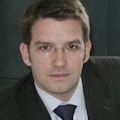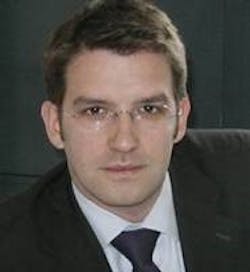Automation systems once only moved within the science fiction world, populating the dreams of generations of Star Trek fans, but have now dramatically accelerated over the last few years to be a part of our daily life.
The development of available technologies to meet growing needs has influenced this acceleration but warp drive speeds were reached with the developments of TESLA or Google Cars (today known as WAYMO), forcing society to accept this reality and start to adapt to it. Star Trek fans now manage our R&D centers.
The result is that automated vehicles are getting a substantial amount of news coverage these days, and for good reason: once they are capable of driverless operation, they may create new efficiencies in our intense lives by carrying out many different tasks. And those opportunities are happening sooner rather than later, as the recent Winter Olympics in South Korea have demonstrated, showcasing many unmanned systems.
The Airport Opportunity
In that world of opportunity opening now, airports will experience an enjoyable position, as many factors currently still slowing down deployment on open roads are not existing on the ramp.
Airports are private environments, setting their own rules and regulations, and therefore able to adapt faster to new technologies or concepts. Airports are also controlled environments, where situations can be anticipated, and a reasonable level of complexity in automation will be sufficient.
Today, the set of operations required for an automatic handling process (as long as we exclude the aircraft operations) could be performed with a restricted level 5 automation, while the complete level 5 automation (full automation for open road driving) is still many years away.
Automated Vehicle: Who are You?
A driverless vehicle is the coordination of different technologies, developed in concert and optimizing their function and performance of each. None of them is individually sufficient, but all are required to ensure the success of a program.
It starts with the vehicle itself. In the GSE world, we should keep in mind that many constraints and specificities have been driving the development of our machines over the past 70 years. From specific speeds, to specific loads via specific heights or frequencies, (almost) everything is specific on an airport.
Developing a driverless GSE product certainly requires to start with an existing GSE product to avoid the long and painful process of discovering problems unique to the ramp.
But, of course, a driverless vehicle is more than GSE. It includes the robotization of the unit, with a steer and drive by wire concept, redundant and failsafe brake systems and a powerful redundant ECU, all this together with a computer monitoring the unit and its environment.
The challenge here is that each technology in all those dimensions are evolving at the very high pace. Each time the annual Las Vegas Consumer Electronic Show is held, for instance, it offers a new set of sensors, ECU or software.
A cooperative effort of industry leaders is an absolute must to keep track of these constant evolutions in technology. In our case, the strategic partnership between TLD and EasyMile, together with specialists in the electronic industry, is allowing our autonomous project to benefit from R&D of innovative leaders in their own respective segments.
The third level of a driverless vehicle program is the fleet management software. Much of the intelligence of the system will consist in the capacity of the machines to interact with their environment and to optimize it. The supervision system is the cornerstone of that interaction, collecting the operational needs, the fleet conditions and the constraints from the environment, turning them into the best possible solution for the operator, at each step of the process.
Finally, a driverless vehicle program is a lot more than a machine. It is about the implementation program. Gathering the different stakeholders, anticipating the roadblocks or the required changes, and managing and implementing the project to ensure a smooth transition is maybe as important as the machine itself. Here, for TLD and EasyMile, the experiences of more than 100 driverless vehicles implemented in more than 20 countries is making a difference.
So, What Will Come Next?
Airport driverless shuttles already exist. The EZ-10 vehicle is currently moving crew around or transferring people from one terminal to another, avoiding the infrastructure impact of a train.
TLD’s TractEasy, a driverless baggage tractor developed together between TLD and EasyMile, will start its operations by summer 2018. It will allow carrying baggage from the terminal to the aircraft area, but still excluding the aircraft final approach.
This last step, operating automatically up to the aircraft, will require further developments, and will likely bring only limited savings, as operators will be needed to load the aircraft – at least for the time being.
Now, Why Should I Do It?
Driverless vehicles are an obvious answer to many ground handling challenges; recruiting and management issues, significant productivity and efficiency improvements, not to mention the safety and process compliance.
They will become, without any doubt, an important factor (not to say the critical factor) of any future ground handler performance roadmap.
But if there is a reason today to launch a driverless vehicle program, it is probably to build your expertise. Those projects will develop fast, probably even faster than what we anticipate today, and your ability to build that critical expertise will be a major differentiation factor for the future in your race for leadership and operational excellence.
Valentin Schmitt is Chief Operating Officer at TLD. He graduated from Ecole des Mines de Paris in 2000 and started his professional careers as consultant at Oliver Wynman in Europe and South America. After having consolidated his experience at Faurecia, a leading tier 1 automotive industry, Valentin joined a French office furniture manufacturer under chapter 11 for a successful turn-around as Chief Operations Officer. In 2008, Valentin joined United Technology (Pratt & Whitney, Sikorsky…) in the Fire & Security division as Commercial Director World for the Oil & Gas activity. Schmitt became CEO of TLD Europe, Middle East & Africa in 2011, before becoming the Group Chief Operating Officer in 2017. TLD is a world leader for Ground Support Equipment with eight factories across three continents and 40 offices to support its customers all around the globe. As part of his role, Schmitt is supporting the TLD autonomous vehicle initiatives, launched in 2013 with the Aircraft Safe Docking system, now mounted on more than 1,000 units in the world. He is a qualified pilot (PPL-A) for land and seaplanes.
About the Author

Valentin Schmitt
Chief Operating Officer
Valentin Schmitt is Chief Operating Officer at TLD. He graduated from Ecole des Mines de Paris in 2000 and started his professional careers as consultant at Oliver Wynman in Europe and South America. After having consolidated his experience at Faurecia, a leading tier 1 automotive industry, Valentin joined a French office furniture manufacturer under chapter 11 for a successful turn-around as Chief Operations Officer. In 2008, Valentin joined United Technology (Pratt & Whitney, Sikorsky…) in the Fire & Security division as Commercial Director World for the Oil & Gas activity. Schmitt became CEO of TLD Europe, Middle East & Africa in 2011, before becoming the Group Chief Operating Officer in 2017. TLD is a world leader for Ground Support Equipment with eight factories across three continents and 40 offices to support its customers all around the globe. As part of his role, Schmitt is supporting the TLD autonomous vehicle initiatives, launched in 2013 with the Aircraft Safe Docking system, now mounted on more than 1,000 units in the world. He is a qualified pilot (PPL-A) for land and seaplanes.
